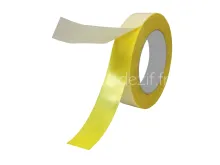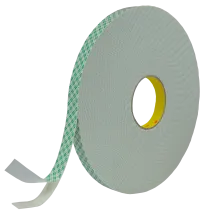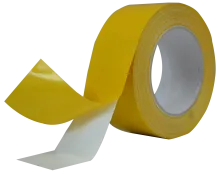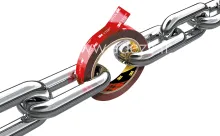Double-sided adhesive tape
Double sided thin
Double-sided transfer tape

Double-sided non woven adhesive

Double-sided PVC adhesive tape

Double-sided polyester adhesive tape

Double-sided polypropylene tape

Double sided thick
Double-sided foam tape

Double-sided cloth adhesive tape

Acrylic foams
3M VHB double-sided adhesive tape

Double-sided viscoelastic acrylic foam

What is a double-sided adhesive tape?
A double-sided adhesive tape is coated with adhesive on both sides. It consists of two fixed elements (the adhesive layer and the liner) and two optional elements (the backing and the adhesion promoter), or if there is no backing (such as in transfer tapes, VHB tapes, or acrylic foam tapes like Scotch VHB), it only consists of a liner and the adhesive layer.
See below the the different components of a double-sided adhesive tape.
The liner on double-sided tape
The liner (also called a protective backing) is essential to prevent the adhesive from sticking to itself once the tape is rolled up.
On a double-sided adhesive tape, the outer face protected by the liner is called the closed face, while the sticky side is called the open face.
The liner can be made of different materials:
Silicone paper: smooth, moisture-resistant
Silicone film: smooth, moisture-resistant, very flexible, and load-resistant
The adhesive layer of double-sided tape
For more details on the adhesives used on single-sided tapes, you can visit our dedicated page on adhesive layers, which provides detailed information on their characteristics and specifications.
Three main types of adhesive layers are distinguished:
Rubber
Rubber adhesives are highly versatile and cost-effective. Their initial adhesion (also known as tack) is excellent, but they generally have medium resistance to aging, UV exposure, and temperature.
Rubber adhesives, whether natural or synthetic, are recommended for bonding on non-polar surfaces and for multi-purpose applications.
Acrylic
This adhesive is typically transparent, making it ideal for applications that require the assembly of transparent materials. Its initial adhesion is average but increases over time. It has excellent resistance to UV, aging, shear, and solvents.
Acrylic adhesives are recommended for permanent and outdoor applications. The vast majority of technical adhesives on the market feature an acrylic adhesive layer.
Silicone
Silicone adhesives have medium initial adhesion but offer excellent resistance to high and low temperatures, UV, and solvents. They are also used for bonding on non-stick surfaces.
Silicone adhesives are typically the most expensive of the three types of adhesives.
The adhesion promoter on double-sided adhesive tape
The adhesion promoter or priming layer is a pre-treatment that helps the adhesive bond to the backing, especially on non-stick surfaces. This ensures good compatibility between the backing and the adhesive, providing reliable and long-lasting adhesion.
The backing of double-sided adhesive tape
In double-sided tapes, the backing is not always present. It is absent in transfer tapes, viscoelastic acrylic foam tapes, and VHB tapes. In these cases, only the adhesive layer and liner are used.
The backing is a thin, flexible material that can be coated with adhesive. Types include: PVC, non-woven backing, polypropylene, polyester, cloth, and foam.
Several characteristics are important in choosing the right backing:
Tear resistance
Elongation until rupture
Resistance when a tear has begun (such as a notch on the edge)
Impact resistance
Abrasion resistance
Water vapor impermeability




